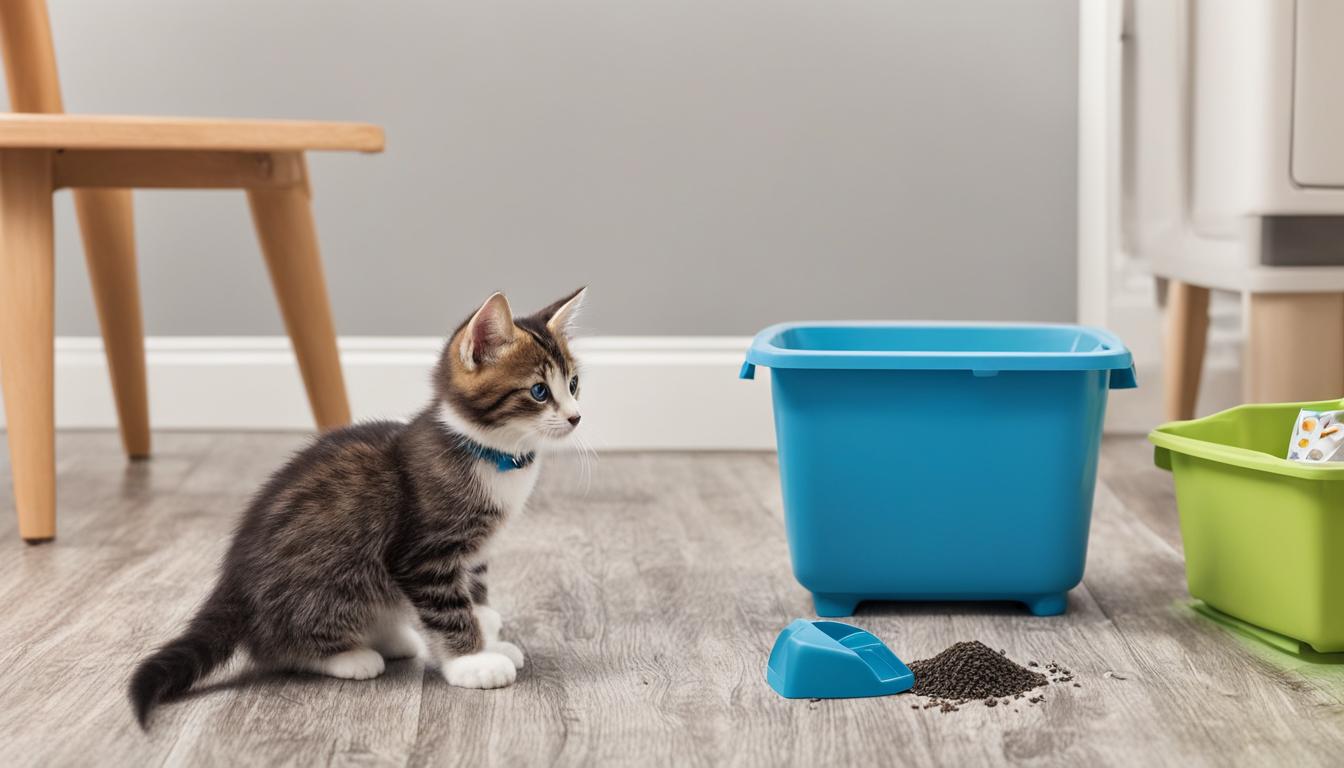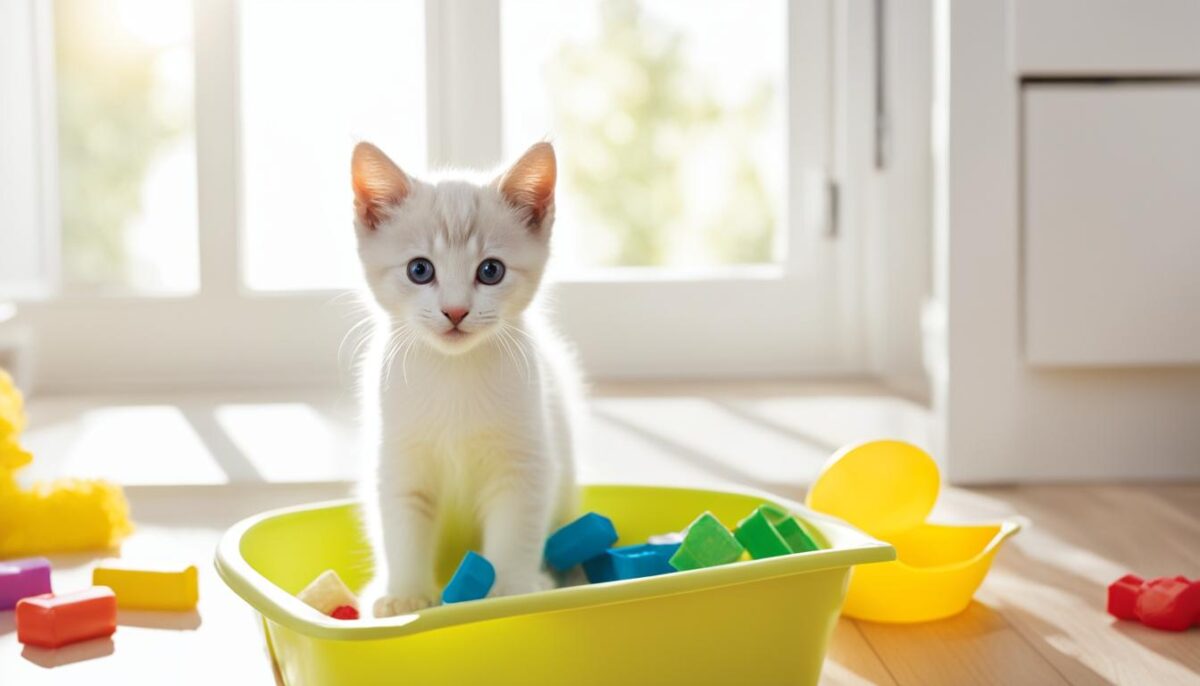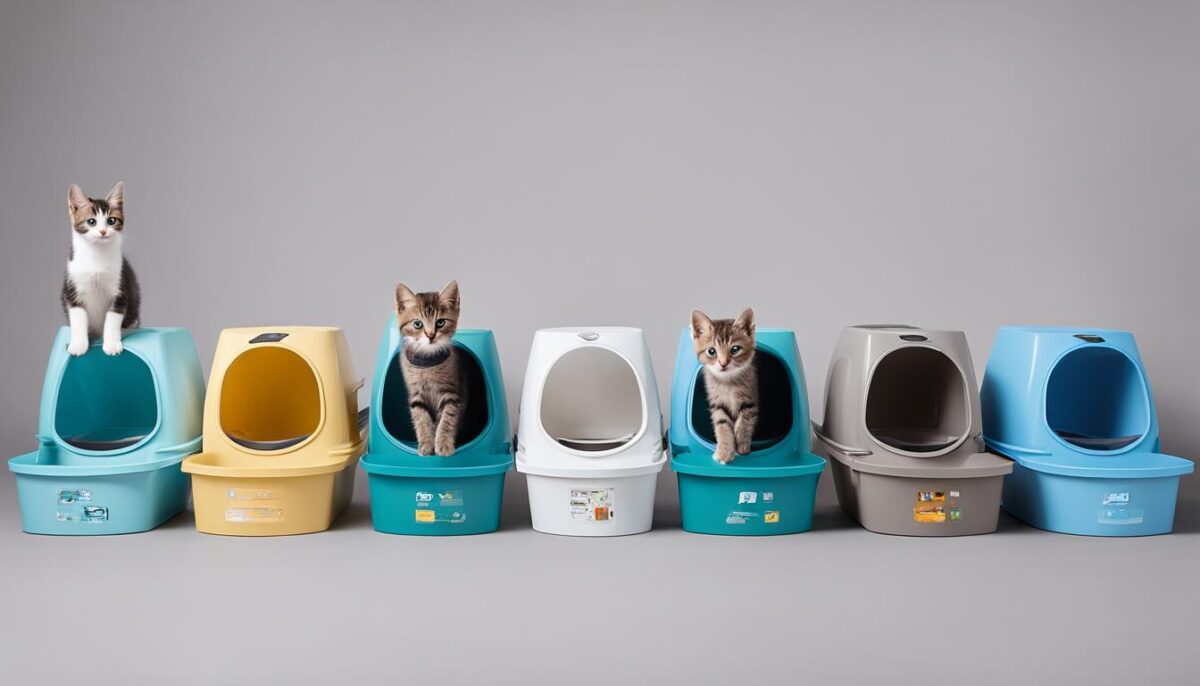Hey there! Are you ready to teach your cute little kitten how to use the litter box? Kittens need to learn where to go when it’s potty time, just like you did when you were a tot. We’ve got some easy tips to help with kitten potty training. Let’s make sure your furry friend knows all about cat bathroom habits.
Little kittens learn to go to the bathroom without their mom’s help after a few weeks. It’s a good idea to start teaching them about the litter box when they’re around 4 weeks old. This is usually when they stop drinking their mom’s milk and start eating other food. If you’ve brought home a kitten older than that or maybe a grown-up cat, you should start litter box training right away.
Litter box training is important because it helps keep your house clean and makes your kitten happy. It’s all about having the right stuff and setting it up before your kitten comes home. You’ll want to show them where the litter box is, and every time they use it right, you can give them a little treat. Make sure to keep the litter box clean so they like using it, and watch out for any signs they might not be feeling well that could make training harder.
Key Takeaways
- Start potty training when your kitten is about 4 weeks old.
- Use the right supplies for litter box training.
- Introduce your kitty to the litter box and give treats for a job well done.
- Keep the litter box clean to help your kitten like it.
- Watch your kitten for any signs of not feeling good that could impact training.
The Importance of Kitten Toilet Training
When you bring a tiny, fuzzy kitten into your home, teaching them where to go potty is a big part of essential kitten care. Just like puppies or babies, kittens need help to learn the right habits. This helps your kitten feel at home and keeps your house clean and smelling fresh.
Understanding Natural Toileting Behaviors
Kittens have instincts that tell them to scratch, bury, and keep their toileting spot clean. Even in the wild, mama cats teach their kittens how to use soft dirt or sand to go potty. In your house, you can help them learn by providing the right kind of litter. This taps into their natural behavior and makes the training process smoother for both of you. Cat behavior understanding is key in this training journey.
Creating a Comfortable Environment
Imagine wanting to use a bathroom that’s not nice—that doesn’t work well for you, right? Your kitten feels the same! Make sure their potty place is comfy and private but also easy for them to get to. A comfortable toileting space for your kitten can include a litter with a gentle texture and a box that’s just the right size.
| Kitten Age | Box Size | Litter Type |
|---|---|---|
| 4-8 weeks | Low-sided tray | Non-clumping |
| 2-6 months | Medium tray | Fine-grained |
| 6+ months | Full-size box | Your kitten’s preference |
The Role of the Trainer in Developing Good Habits
And who’s the trainer? That’s you! Be patient and give your kitten lots of love as they learn. When they do well, give them a treat to let them know they’re doing a great job. If they make a mistake, don’t be mad—just clean it up and try again. It’s all about being kind and steady in your teaching.
When to Begin Toilet Training a Kitten
Is your little kitten ready to learn how to use a litter box? The best time to start is when they are about four weeks old. This is usually when kitten weaning begins, and they start eating solid food. Just like babies learn to use a potty, kittens can start early litter box training. You might wonder, “What is the optimal training age for a kitten?” The answer is as soon as they come into your home!
If you’ve just brought home a new kitty, no matter if it’s a young one or an adult, it’s time to train. Older cats can learn, too. It’s like the saying, “You can’t teach an old dog new tricks.” Well, with cats, you can!
Having a kitten-friendly litter box helps make this change easier. Let’s look at what you need to make this happen:
- A litter box that’s just right for your kitten
- Some litter that is soft and easy for them to dig in
- A quiet spot where your kitten can go without being scared
See how easy it can be? With a little love and the right tools, your kitten will be using the litter box in no time.
Choosing the Right Litter Box for Your Kitten
Hey there, cat friend! If you’ve got a cute little kitten at home or if you’re getting one soon, you’ll need to think about where they’re going to do their business. Just like you have preferences for your bathroom, kittens have likes and dislikes too, especially when it comes to their litter box.
Considering Size and Accessibility
Your tiny friend might be small now, but they will grow fast! You want to start with a litter tray that’s just the right size. Appropriate litter tray size means they can hop in and out without any trouble, and they have enough room to move around. Vet expert Dr. Sally J. Foote suggests a size that’s about 13 by 9 inches to begin with.
As your kitten grows, they’ll need more space, so you’ll need to get a bigger box. For grown-up cats, a good rule to follow is to pick a box that’s 1 1/2 times their length. And if you’re in a multiple cat household, more boxes are better – it means less waiting and no fighting for turns!
Open vs. Covered Litter Boxes
Kittens, like adult cats, can be picky about their toilets. Some like to have a cover for a bit of privacy, but others might feel like they’re trapped. If you’re not sure what your kitten prefers, you can try both. The key is to watch and learn what they like best!
Number of Litter Boxes Needed
If you’ve got more than one furry friend, you’ll want to have enough boxes for them all. In fact, it’s smart to have one more box than the number of cats in your home. This means everyone has their own space, and there’s always a free spot when nature calls. Check out this table to understand how many boxes you might need:
| Number of Cats | Minimum Number of Litter Boxes |
|---|---|
| 1 Cat | 2 Litter Boxes |
| 2 Cats | 3 Litter Boxes |
| 3 Cats | 4 Litter Boxes |
| 4 Cats | 5 Litter Boxes |
Remember, your kitten’s comfort and your home’s harmony depend on these choices. Take note of your kitten box preferences, and you’ll be all set. Now go on and give your little buddy a litter box they can’t wait to use!
Selecting the Best Litter for Kittens
When it comes to picking the right litter for your new furry friend, you want to make sure it’s as comfy as a cozy bed. Let’s find the litter that makes your kitten’s paws do a happy dance!
Exploring Different Types of Litter Materials
Different kittens like different things—just like us! Some might love snuggly fine-grain litter, while others might go for the big chunky kind. Think of it like choosing between a smoothie or a milkshake. Both are yummy—it’s just what tickles your taste buds!
Why Kittens Might Prefer Certain Litters
Your tiny tiger might act like the king of the jungle, but when it comes to litter, they might be a bit picky. Some kittens dig the clumping litter because it’s easy to scoop. Others might not care about clumping vs. non-clumping—they just want something soft for their little paws. It’s all about finding that perfect litter texture preference!
How to Test Litter Preferences
Ready for a fun science experiment? Try out a few different litters and see which one your kitten uses the most. It’s like having a mini treasure hunt to find the ‘purrfect’ litter!
Remember, finding the right litter isn’t just about what you think is best—it’s all about making your kitten’s whiskers twitch with joy. When they’re happy, they’ll have no problem using their litter box, and that means you’re both on the path to a clean and happy home!
Ideal Placement for Kitten Litter Boxes
Finding the perfect spot for your kitten’s litter box is important. You’ll want to make it a comfortable bathroom area for them. This means thinking about where to put the litter box so your furry friend can find it and use it easily. Let’s talk about the best places for a litter box, so your kitten feels safe and happy when it’s time to go!
Accessibility and Visibility
Your kitten’s litter box should be in a place that is easy-to-reach. Young kittens like things they can find without trouble. You’ll want to make sure the litter box isn’t hidden away or too far from where they like to play and sleep. This might mean having a litter box on each floor of your house if you have more than one level.
Avoiding High-Traffic and Noisy Areas
Kittens can be shy, so you don’t want their litter box in a busy or loud place. They need a quiet spot to go to the bathroom. Keep their litter box away from places where people walk a lot or where there are machines that make noise, like washing machines or dryers. This helps your kitten feel safe and not frightened when they use the litter box.
Keeping It Near Their Habitat Without Compromising Privacy
A kitten’s litter box should be close to where they spend most of their time but still out of the way so they have privacy. Put the litter box in a corner, but not so hidden that your kitten feels trapped. And remember, you don’t want the litter box too close to where your kitten eats or sleeps. Just like us, kittens don’t like to eat near their bathroom!
| Tips for Litter Box Location | Why It’s Important |
|---|---|
| Easy to find and reach | So your kitten can use it without getting lost or confused |
| Away from busy, noisy areas | So your kitten feels secure and not scared |
| Not too close to food or bed | For a clean and comfortable space where your kitten can be happy |
Remember, the perfect litter box location is all about making your kitten feel at home. When you get it right, your furry little friend will have their own special spot that’s just for them. They’ll thank you with happy purrs and cuddles!
Introducing Your Kitten to the Litter Box
When you start teaching your kitten where to go potty, the first thing is to make sure they know where the litter box is. You can hold your little cat and let them see and smell the litter box. Be gentle when you put them down in it. Some kittens might jump right in, but others might need a little help. That’s okay!
First Encounters: Making It a Positive Experience
To help your kitten understand the litter box is a good place, show them how to use it. Take your finger and pretend it’s a little paw, scratching the litter just like they would. It’s like playing in the sand. Isn’t that fun? When your kitten tries it out for real and does it right, give them a little treat. This lets them know they did a great job!
Demonstrating the Proper Use
Every now and then, remind your kitten where the litter box is, especially after they eat or wake up from a nap. This helps them remember to use it. If your kitten forgets and has an accident, clean it up with a special soap that gets rid of any smell. This way, your kitten won’t think that’s the new bathroom spot!
Celebrating Successful Use with Rewards
Rewarding good behavior with a small treat can really help your kitten learn faster. When they use the litter box, make sure to smile and give them a nice pet. This is super encouraging for your kitten to keep using the litter, and they will want to do it more to make you happy!
FAQ
At what age should I start litter box training my kitten?
You should start litter training around 4 weeks of age, which is typically when kittens begin weaning and are developmentally ready to learn how to use a litter box.
How do I understand and work with my kitten’s natural toileting behaviors?
Observe your kitten as it starts practicing natural behaviors like scratching, depositing, and covering under its mother’s guidance. Encourage these instincts in your home by providing an appealing and proper litter box setup.
What type of litter box environment is comfortable for kittens?
A comfortable toileting space for kittens includes a clean litter box that is accessible and of the right size. Avoid placing it in high-traffic areas to ensure privacy and safety.
What is the role of the trainer when toilet training a kitten?
As a trainer, your role is to be patient, consistent, and provide positive reinforcement. Reward your kitten for using the box correctly, and do not punish them for mishaps, to help them develop good litter box habits.
How many litter boxes do I need for multiple cat households?
You should maintain more litter boxes than the number of cats in your household to reduce competition and ensure each cat has accessibility to a clean box.
What’s the difference between clumping and non-clumping litter, and which is better for kittens?
Clumping litter forms solid clumps when wet, making cleanup easier. Non-clumping litter absorbs moisture without clumping. Kittens often prefer fine-grain clumping litter, but it can vary by individual preference.
Why might my kitten have a litter preference?
Kittens may prefer certain types of litter due to texture, smell, or past experiences. For example, some kittens might reject corn- or wheat-based litters due to their food-like smell. It’s important to observe and accommodate your kitten’s preferences.
How do I test my kitten’s litter preferences effectively?
Set up different litter boxes with various types of litter and observe which one your kitten uses more frequently. This can include experiments with fine-grain, clumping, clay, or plant-based litters.
Where should I locate my kitten’s litter box in my home?
Place the litter box within reach on every floor of your home, away from noisy appliances and from where your kitten eats and sleeps. Ensure privacy and safety without tucking it away in hard-to-reach corners.
How can I make sure the litter box is both visible and accessible to my kitten?
Keep litter boxes in quiet, well-lit areas, perhaps with a night-light for visibility, and make sure they are not blocked by furniture or other barriers that could limit your kitten’s access.
How do I introduce my kitten to their litter box and encourage proper use?
Allow your kitten to explore and sniff the litter box naturally. Then, gently place them inside, showing them how to dig. Remember to reward them with treats after successful use to create a positive association.
How should I celebrate my kitten’s successful litter box use to ensure continued success?
Celebrate your kitten’s success by offering immediate rewards, like treats or affection, every time they use the litter box correctly. This helps reinforce the good behavior and makes them more likely to repeat it.


